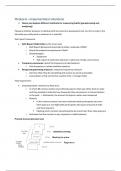Samenvatting
Summary Addiction & Compulsive Disorders: implementation intentions, eating disorders, pathological gambling & OCD
This summary is based on the learning objectives of the lectures and contains college notes, slides & literature. It is about the subjects implementation intentions, eating disorders, pathological gambling and the symptomatology & treatment and the role of habits in obsessive-compulsive disorder.
[Meer zien]




